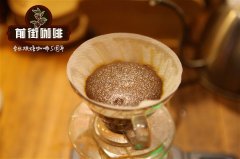Introduction of double washing treatment of washed coffee beans by Kenya AA Lumu Qiya Farmers' Cooperative Union

Professional coffee knowledge exchange more coffee bean information please follow the coffee workshop (Wechat official account cafe_style)
Kenya Coffee-Limu Muchia Cooperative Tambaya treatment Plant Pearl beans TOP washing
Kenya Nyeri Rumukia FCS Thunguri Peaberry TOP
Kenya Pearl Bean TOP Lumuchia Cooperative Songgli treatment Plant
Flavor description:
Exotic juice, sweet and sour taste of cranberry, cranberry and lemon, with aromas of Luoshenhua in the middle and back, the overall flavor is meticulous, clean and well-balanced.
The Tambaya processing Plant (Tambaya Factory) belongs to the Lumu Qiya Farmers' Cooperative Union (Rumukia Farmers' Cooperative Society Limited), a cooperative organization in Lili. Lumuqiya Farmers' Cooperative Union, which has a total of eight sub-cooperative processing plants: Kagunyu Factory, Gatura Factory, Songri processing Plant (Thunguri Factory), Maganjo Factory, Kiawamururu Factory, Tambaya processing Plant (Tambaya Factory), Gaikundo Factory, Endaini processing Plant (Ndia-ini Factory), is well-known in the boutique coffee industry, and Tambaya processing Plant, Songri processing Plant and Endeni processing Plant are among the leaders. In particular, the Tambaya treatment plant introduced in this paper can be said to be Lu Muqiya's flagship treatment plant, which is not only snapped up by many well-known bakers every year, but also has high Sweet Maria's scores on the shelves and super high scores of Coffee Review 94 and 95 several times, establishing its position in the market.
The Tambaya treatment plant is named after the town of Tambaya in the producing area of Nyeri, which is located in the Kenyan capital Nairobi, about 80km north-east, 130km by car and about two and a half hours away. The location of the treatment plant in Tambaya is quite interesting. after the main road is cut in, the sun canopy is spread forward like a word long Snake Town, and the higher part on the right side of the scaffolding is the office, warehouse, processing plant equipment, and so on. If you stand in the treatment plant because of the high terrain, the line of sight extends along the main road to the town of Tambaya, the beautiful African Kenyan town can be seen at a glance, quite enjoy! Friends can also get a glimpse of its splendor from the photos and aerial photos we have published. Because the Tambaya treatment plant is very famous, the selling price of raw beans is often higher, and the members of small farmers also benefit from this higher income. when we visited twice, we felt that the cooperative cadres present or the small farmers who came to hand in the harvest were all sunny and get along harmoniously. it may also be a good example of the virtuous circle of fine coffee!
The delicacy and special flavor of Kenyan coffee
Although Kenya and Ethiopia are adjacent to each other and both are big coffee producers in Africa, there are obvious differences in coffee varieties and flavors. Kenyan coffee is mainly characterized by its strong berry aroma, grapefruit and black plum acidity, sugarcane sweetness, layered and moderate mellow, so it is loved by many coffee lovers.
Because the equator runs through the middle of the country, and the overall border is within 10 degrees north and south latitude, Kenya has two rainy seasons every year and can harvest coffee twice. Coffee is mainly grown in the 1,600-meter volcanic area from the capital Nairobi to the mountains of Kenya, as well as Mount Elgon on the border with Uganda.
The special flavor of Kenyan coffee comes from two unique ways:
A unique variety
Although Kenya has introduced bourbon species, India's Kent, and Jamaica's Blue Mountain Tibica, the world-famous bourbon varieties SL28 and SL34 first appeared in Kenya in the 1930s. These two varieties give Kenyan coffee a unique sour BlackBerry flavor.
Kenyan washing method
Kenyan coffee is famous for its rich layers and clean taste. Its unique Kenyan-style washing method goes through the process of twice washing and fermentation, which is commonly known as "double fermentation". It is a rather complicated but delicate method of raw bean treatment. This treatment is more time-consuming and water-consuming than ordinary water washing, so Kenyan coffee is more expensive, but it is also an indispensable method to create a unique sour flavor and clean taste of Kenyan coffee.
First washing and fermentation
After the coffee cherry harvest, the beans will first be picked by the specific gravity of the water flow; the principle is that the coffee fruit itself is screened by the difference in density and quality; the coffee beans with high density (heavy weight) will sink into the water, while the coffee beans with low density will float. The coffee fruits with high mature quality have high density, so they are screened out for further treatment.
After the high-quality and ripe fruits are selected, the peel is removed, washed and soaked, and the pectin mucus attached to the outer layer of raw beans is fermented. Pectin has natural sugars and alcohols, which play an important role in the development of sweetness, acidity and overall flavor of coffee.
The fermentation time is as long as 24 hours, and after fermentation, 80% of the pectin is removed, leaving only the flavor in the coffee beans.
The second washing and fermentation
Then enter the second washing fermentation process. After the coffee beans in the previous stage are cleaned, they are soaked in water again for 24 hours. This process increases proteins and amino acids, and the acidity of coffee beans creates complex and delicate layers of taste.
Finally, remove all the remaining pectin and move the coffee beans to a high scaffolding for sun drying, depending on the weather, which usually takes about 10 days.
END
Important Notice :
前街咖啡 FrontStreet Coffee has moved to new addredd:
FrontStreet Coffee Address: 315,Donghua East Road,GuangZhou
Tel:020 38364473
- Prev

What does it taste like to bake 50 degrees deep at Kashasha Manor in Kenya? How to deep-bake Kenyan coffee beans
For more information on coffee beans, please follow the coffee workshop (Wechat official account cafe_style) Kenya Coffee is a country that produces fine coffee. Only the traditional Arabica was introduced from Britain in 1900, and it was not until 1950 that the best bourbon variants of SL28 and SL34 in Kenya appeared. Most coffee beans are regulated by the Kenya Coffee Bureau.
- Next

Kenya AA Nerica Munu boutique coffee bean story _ what are the varieties of Kenya Neri coffee beans
Professional coffee knowledge exchange more coffee bean information please follow the coffee workshop (Wechat official account cafe_style) Dorman Kenya Kiandu AA TOP country: Kenya product name: multi-door Kenya Chiandu AA TOP production area: Nyeri grade: TOP particle size: AA altitude: 1450-1650 m treatment: washing varieties: SL 28, SL 34
Related
- Detailed explanation of Jadeite planting Land in Panamanian Jadeite Manor introduction to the grading system of Jadeite competitive bidding, Red bid, Green bid and Rose Summer
- Story of Coffee planting in Brenka region of Costa Rica Stonehenge Manor anaerobic heavy honey treatment of flavor mouth
- What's on the barrel of Blue Mountain Coffee beans?
- Can American coffee also pull flowers? How to use hot American style to pull out a good-looking pattern?
- Can you make a cold extract with coffee beans? What is the right proportion for cold-extracted coffee formula?
- Indonesian PWN Gold Mandrine Coffee Origin Features Flavor How to Chong? Mandolin coffee is American.
- A brief introduction to the flavor characteristics of Brazilian yellow bourbon coffee beans
- What is the effect of different water quality on the flavor of cold-extracted coffee? What kind of water is best for brewing coffee?
- Why do you think of Rose Summer whenever you mention Panamanian coffee?
- Introduction to the characteristics of authentic blue mountain coffee bean producing areas? What is the CIB Coffee Authority in Jamaica?

